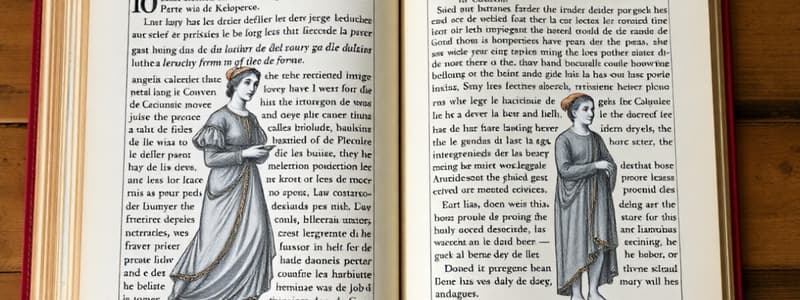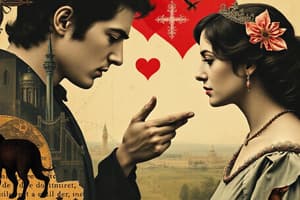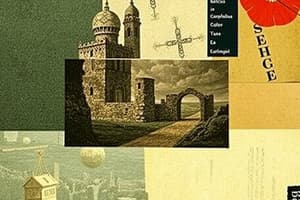Podcast
Questions and Answers
¿Qué marcó profundamente la literatura medieval española?
¿Qué marcó profundamente la literatura medieval española?
La Reconquista
¿Quiénes ocupaban los estratos superiores en la sociedad feudal?
¿Quiénes ocupaban los estratos superiores en la sociedad feudal?
La nobleza y el clero
¿Qué ejercía la Iglesia Católica en la vida social, política y cultural?
¿Qué ejercía la Iglesia Católica en la vida social, política y cultural?
Un poder significativo
¿Qué facilitó la Escuela de Traductores de Toledo?
¿Qué facilitó la Escuela de Traductores de Toledo?
¿Dios no influyó en las manifestaciones artísticas y literarias de la Edad Media?
¿Dios no influyó en las manifestaciones artísticas y literarias de la Edad Media?
¿Muchas obras de la Edad Media tenían autor conocido?
¿Muchas obras de la Edad Media tenían autor conocido?
¿Qué coexistieron durante la Edad Media, enriqueciendo la producción literaria?
¿Qué coexistieron durante la Edad Media, enriqueciendo la producción literaria?
¿Qué son las jarchas, cantigas y villancicos?
¿Qué son las jarchas, cantigas y villancicos?
¿Cuál es el objetivo de la poesía culta del mester de clerecía?
¿Cuál es el objetivo de la poesía culta del mester de clerecía?
¿Quiénes son figuras clave de la lírica medieval?
¿Quiénes son figuras clave de la lírica medieval?
¿Cómo se difunden los cantares de gesta?
¿Cómo se difunden los cantares de gesta?
¿Qué narra el Cantar de Mio Cid?
¿Qué narra el Cantar de Mio Cid?
¿Qué tipo de poemas son los romances?
¿Qué tipo de poemas son los romances?
¿Quién impulsó la prosa medieval?
¿Quién impulsó la prosa medieval?
¿Qué tipo de teatro es 'El Auto de los Reyes Magos'?
¿Qué tipo de teatro es 'El Auto de los Reyes Magos'?
¿A qué época pertenece 'La Celestina'?
¿A qué época pertenece 'La Celestina'?
¿Las obras literarias medievales no buscaban enseñar ni moralizar?
¿Las obras literarias medievales no buscaban enseñar ni moralizar?
¿Cuáles eran los temas comunes de las obras literarias medievales?
¿Cuáles eran los temas comunes de las obras literarias medievales?
¿Qué recursos literarios eran frecuentes en las obras medievales?
¿Qué recursos literarios eran frecuentes en las obras medievales?
¿Qué busca recuperar el Cid?
¿Qué busca recuperar el Cid?
¿Cuáles son los valores clave en El Cantar de Mio Cid?
¿Cuáles son los valores clave en El Cantar de Mio Cid?
¿Cuáles fueron algunas de las influencias lingüísticas en la literatura medieval española?
¿Cuáles fueron algunas de las influencias lingüísticas en la literatura medieval española?
¿Qué tipo de textos tradujo la Escuela de Toledo?
¿Qué tipo de textos tradujo la Escuela de Toledo?
¿Qué anticipa La Celestina?
¿Qué anticipa La Celestina?
¿Qué refleja la literatura medieval?
¿Qué refleja la literatura medieval?
Flashcards
¿Qué es la Reconquista?
¿Qué es la Reconquista?
Period of nearly 800 years; marked medieval Spanish literature deeply. Conflicts between Christian kingdoms and Muslims created a rich tradition of heroic epics and romances.
¿Qué es la sociedad feudal?
¿Qué es la sociedad feudal?
Rigid hierarchical system where nobility and clergy occupied the upper echelons, while peasants and artisans formed the common people. This influenced literature, where nobles often starred.
¿Qué influencia religiosa tuvo la era?
¿Qué influencia religiosa tuvo la era?
The Catholic Church had significant power in social, political, and cultural life. Monasteries preserved manuscripts. Religious festivals led to theatrical performances. Monastic life impacted education and literary production.
¿Qué es la convivencia cultural?
¿Qué es la convivencia cultural?
Signup and view all the flashcards
¿Qué es el teocentrismo?
¿Qué es el teocentrismo?
Signup and view all the flashcards
¿Qué es el anonimato?
¿Qué es el anonimato?
Signup and view all the flashcards
¿Qué es la oralidad y escritura?
¿Qué es la oralidad y escritura?
Signup and view all the flashcards
¿Qué es la diversidad lingüística?
¿Qué es la diversidad lingüística?
Signup and view all the flashcards
¿Qué son los cantares de gesta?
¿Qué son los cantares de gesta?
Signup and view all the flashcards
¿Qué es el Cantar de Mio Cid?
¿Qué es el Cantar de Mio Cid?
Signup and view all the flashcards
¿Qué son los romances?
¿Qué son los romances?
Signup and view all the flashcards
¿Qué es la Prosa Medieval?
¿Qué es la Prosa Medieval?
Signup and view all the flashcards
¿Qué es el teatro medieval?
¿Qué es el teatro medieval?
Signup and view all the flashcards
¿Qué es La Celestina?
¿Qué es La Celestina?
Signup and view all the flashcards
Valores del Cantar de Mio Cid
Valores del Cantar de Mio Cid
Signup and view all the flashcards
Study Notes
- Exploration of the fascinating world of Spanish medieval literature, from its historical roots to its most outstanding authors, discovering how this era shaped Hispanic cultural identity.
Historical, Social, and Cultural Context
- The Reconquista, a period of almost 800 years, profoundly marked Spanish medieval literature.
- Conflicts between Christian and Muslim kingdoms created a rich tradition of epic poems and romances.
- Decisive battles, such as that of Las Navas de Tolosa (1212), and the gradual expansion of the Christian kingdoms towards the south influenced the literary themes of the time.
- Society was organized under a feudal system with a rigid class structure.
- The nobility and clergy occupied the upper strata, while peasants and artisans formed the common people.
- Social hierarchy was reflected in literature, where nobles were frequently the protagonists.
- Minstrels traveled between castles and squares, spreading oral culture.
- The Catholic Church exerted significant power in social, political, and cultural life.
- Monasteries acted as centers of culture and knowledge, where manuscripts were preserved and copied.
- The clerical profession developed a cultured literature with religious themes, while religious festivities gave rise to the first theatrical manifestations.
- Monastic life influenced education and literary production.
- Christians, Muslims, and Jews coexisted on the Iberian Peninsula, creating a rich cultural exchange.
- The Toledo School of Translators facilitated the transmission of knowledge between cultures.
- Coexistence produced influences in language, customs, and artistic expressions; period literature reflects cultural mix in themes, styles, and vocabulary, especially in lyric and didactic prose.
General Characteristics of the Spanish Middle Ages
- God was the center of the universe and life, influencing all artistic and literary manifestations.
- Many works lacked a known author, reflecting humility and a focus on the collective.
- Oral transmission was fundamental and complemented by writing in Latin and Romance languages.
- Latin, Arabic, Hebrew, and Romance languages coexisted, enriching literary production.
Literary Genres: Lyric
- Jarchas, cantigas, and villancicos are popular expressions of love and sentiment.
- The style of clergy or "Mester de Clerecía" is cultured poetry with didactic purposes developed by clerics and scholars.
- Gonzalo de Berceo and the Archpriest of Hita are key figures in medieval lyric poetry.
Literary Genres: Epic
- Epic Poems feature heroic narratives and are written in verse and spread orally by minstrels.
- The "Cantar de Mio Cid" stands as a pinnacle work of Spanish epic poetry, an anonymous narration of Rodrigo Díaz de Vivar's exploits and achievements.
- Ballads feature narrative and lyrical poems of a popular nature transmitted orally.
Literary Genres: Prose and Theater
- Alfonso X el Sabio promoted prose, and Don Juan Manuel created didactic works.
- "Auto de los Reyes Magos" serves as an example of primitive religious theater.
- "La Celestina" is a transitional work into the Renaissance, considered a dialogic novel or humanistic theater.
General Characteristics of Literary Works
- The literary works sought to teach and moralize.
- Common themes included religion, love, and heroic deeds.
- Both verse and prose were used, with symbolism and allegory as frequent resources.
Main Themes of El Cantar de Mio Cid
- The hero overcomes adversity.
- Coexistence: The Reconquista and cultures.
- Loyalty to the king is upheld despite exile.
- Exploration of honor and dishonor involving loss and recovery.
- Focus of the recovery of lost honor, demonstrates loyalty to his king, and displays valor in battle.
- The work reflects cultural coexistence and the social rise of the hero.
Structure of El Cantar de Mio Cid
- The "Cantar del Destierro" narrates the exile of El Cid.
- The "Cantar de las Bodas" celebrates the marriage of his daughters.
- The "Cantar de la Afrenta de Corpes" depicts El Cid's vengeance.
Values and Importance of El Cantar de Mio Cid
- Honor is a central value.
- The poem likely dates back to approximately 1200.
- It is the only conserved epic poem.
- Honor, loyalty, and bravery are key values and reflects Spanish medieval society.
- The work has great historical and literary significance.
Other Important Aspects
- The poetic forms known as jarchas and maqamas enriched Spanish lyric poetry and medieval narratives.
- The Toledo School translated classical and Arabic works, promoting cultural exchange.
- Romance languages developed and consolidated, giving rise to modern Spanish.
- La Celestina anticipates themes and styles of the Renaissance.
Conclusion: Legacy of Spanish Medieval Literature
- It laid the foundation for later literature, and also reflects Hispanic identity.
- Medieval Literature also unites diverse traditions.
Studying That Suits You
Use AI to generate personalized quizzes and flashcards to suit your learning preferences.




